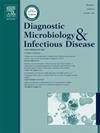Successful treatment of infections caused by mycobacterium abscessus complex following aesthetic procedures: A case series in China
IF 2.1
4区 医学
Q3 INFECTIOUS DISEASES
Diagnostic microbiology and infectious disease
Pub Date : 2024-11-19
DOI:10.1016/j.diagmicrobio.2024.116621
引用次数: 0
Abstract
Background
Aesthetic procedure-associated infections caused by Mycobacterium abscessus complex (MABC) have been an emerging concern. However, limited evidence is available on this topic, and there are no standard treatments. The selection of antimicrobial regimens for the effective treatment of MABC infections poses a significant challenge.
Case presentation
In this case series, we present three patients in China who developed MABC infections following various aesthetic procedures. Two patients presented with localized skin and soft tissue infections, whereas one patient developed a disseminated infection. Treatment involved a combination of intravenous amikacin and cefoxitin for more than two weeks, followed by an oral regimen comprising clarithromycin, linezolid, and moxifloxacin based on drug susceptibility testing results. Despite the treatment's efficacy, the patients experienced adverse reactions to the antibiotics, including gastrointestinal symptoms, anaemia, and hearing loss. All patients achieved successful outcomes with shorter treatment courses and no relapse during the 3-year follow-up period.
Conclusion
This case series emphasizes the importance of employing appropriate combination antibiotic therapies based on drug susceptibility testing results for aesthetic procedure-associated infection caused by MABC when specific subspecies are unidentified. The combination of intravenous aminoglycosides and cefoxitin, followed by oral sequential therapy, with the course of treatment specifically tailored to the severity of the infection, provides a valuable treatment reference for patients with MABC infections in China.
成功治疗美容手术后的复合脓肿分枝杆菌感染:中国的系列病例
背景由复合脓肿分枝杆菌(MABC)引起的美容手术相关感染已成为一个新的关注点。然而,目前有关这一主题的证据有限,也没有标准的治疗方法。在本病例系列中,我们介绍了中国三位在接受各种美容手术后发生脓肿分枝杆菌感染的患者。其中两名患者出现局部皮肤和软组织感染,一名患者出现播散性感染。治疗包括静脉注射阿米卡星和头孢西丁两周以上,然后根据药敏试验结果口服克拉霉素、利奈唑胺和莫西沙星。尽管疗效显著,但患者仍出现了抗生素不良反应,包括胃肠道症状、贫血和听力下降。结论:本系列病例强调了在未确定具体亚种的情况下,根据药物敏感性检测结果采用适当的抗生素联合疗法治疗由 MABC 引起的美容手术相关感染的重要性。静脉注射氨基糖苷类药物和头孢西丁,然后口服序贯疗法,疗程根据感染的严重程度而定,为中国的 MABC 感染患者提供了有价值的治疗参考。
本文章由计算机程序翻译,如有差异,请以英文原文为准。
求助全文
约1分钟内获得全文
求助全文
来源期刊
CiteScore
5.30
自引率
3.40%
发文量
149
审稿时长
56 days
期刊介绍:
Diagnostic Microbiology and Infectious Disease keeps you informed of the latest developments in clinical microbiology and the diagnosis and treatment of infectious diseases. Packed with rigorously peer-reviewed articles and studies in bacteriology, immunology, immunoserology, infectious diseases, mycology, parasitology, and virology, the journal examines new procedures, unusual cases, controversial issues, and important new literature. Diagnostic Microbiology and Infectious Disease distinguished independent editorial board, consisting of experts from many medical specialties, ensures you extensive and authoritative coverage.

 求助内容:
求助内容: 应助结果提醒方式:
应助结果提醒方式:


